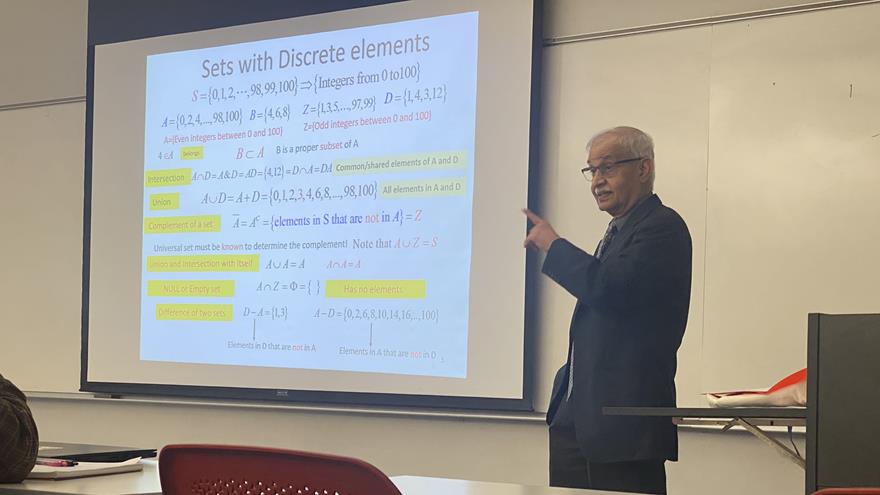Meet P. Mohana Shankar, Recipient of the Inaugural Provost Award for Pedagogical Innovation
By Natalie Kostelni

While teaching differential equations to engineering students back in 2010, P. Mohana Shankar, PhD, assigned the class to solve a standard question. Since the solution to the problem required explanation and interpretation, Shankar later wondered whether the students would learn more if they were each provided with a unique question.
Such a step would be time-intensive, requiring the creation of multiple questions of near equal rigor along with their solutions. But with this approach, students could examine and explore individually, while also benefitting from a collective learning experience, since the procedure to solve the questions would be the same.
That was the beginning of an undertaking in which Shankar, a professor in the Department of Electrical & Computer Engineering, would provide unique questions to each student every week during the course.
By 2015, Shankar was teaching Probability and Statistics for undergraduate students in Electrical and Computer Engineering. It’s a required course for students pursuing an undergraduate degree in engineering, and one in which students often struggle. Shankar concluded this was because of a disconnection between studying theorems and applying them to real-world scenarios. The cause of this dissonance came as no surprise to Shankar; it was the way the course was structured and taught.
“Data-driven examples were nonexistent in the course menu,” he said. “The existing crop of textbooks contained very little information on data analytics and very few books provided examples in line with current issues of data collection, mining, modeling, and interpretation, all of which rely on statistics. I realized students could learn more if I taught the basics and then gave each a differential equation to solve.”
This motivated Shankar to create a new and innovative statistics course called Probability and Data Analytics for Engineers (ECE 361). The course draws from Shankar’s approach honed during his prior work and brings an individualized experience to each student without sacrificing core elements of probability and statistics.
“That meant that if I have 60 students, I came up with 60 different problems and 60 different solutions,” Shankar said. “I want students to figure out for themselves much more about what and why they are being taught. It’s a process of self-discovery.”
Shankar also ensured his approach directly linked theoretical concepts to practical applications in areas such as artificial intelligence, machine vision and medical diagnostics.
In 2023, Shankar was among four Drexel faculty recognized for implementing outstanding innovations in teaching and learning with the inaugural Provost Award for Pedagogical Innovation. As articulated in the award description, “Pedagogical innovation refers to the development of new ways of teaching, delivering curricula, interdisciplinary methods, or interfacing with the community or the workforce to create and implement novel courses and learning experiences.”
In this interview, Shankar shared his thoughts on developing the course and his approach to teaching.
How would you describe the course to a new engineering student?
This course provides a bridge between theoretical concepts and practical uses of data mining, data analysis, and data reduction, etc. for applications in engineering, medicine, business, and research.
Why is it important to give different data sets to students?
The reasons are simple. I have been at Drexel since 1982. I know that if I give one data set to the students what happens — at best — is I may have 50% to 60% of the students trying to attempt that problem on their own and the rest might work in groups or resort to getting help from other sources. That means learning may not be taking place. I generally tell students that I can only teach; learning has to come from them. For learning to take place, there must be some self-discovery.
How often is the course taught?
The course is offered every quarter, and the number of students varies from 35-80 per quarter.
How have students reacted to the course?
They have been very responsive and have connected what they have learned to real-world applications. For example, one student shared that they were excited to take the material learned and apply it to their next co-op, which involved working on machine vision on robots for serialization on manufacturing lines. I had a student share that they were glad to have had ‘this exact final project and homework topics, because I will be able to use nearly the same topic in the field of engineering.’ It was also heartening when a student shared that that the class had ‘opened my mind to a new horizon and I think every engineering student should take this class.’
Why do you think the reaction has been so positive?
I think there are several reasons. Students experience immediate and direct connection to what they learn as soon as they finish the course. When the students are taking the course, they don't like it. They dislike the course, and they dislike me. Then, by the eighth or ninth week, some of them have had co-op interviews and wherever they are being interviewed, suddenly they hear terms used from the class and can respond to the person who is interviewing them with confidence and discuss what they have learned.
Aside from the feedback from students, have colleagues assessed the course?
All aspects of this new course have been disseminated to the scientific community through peer-reviewed journal publications. Some of these contain indirect assessments based on student surveys and another set offers a means of direct assessment.